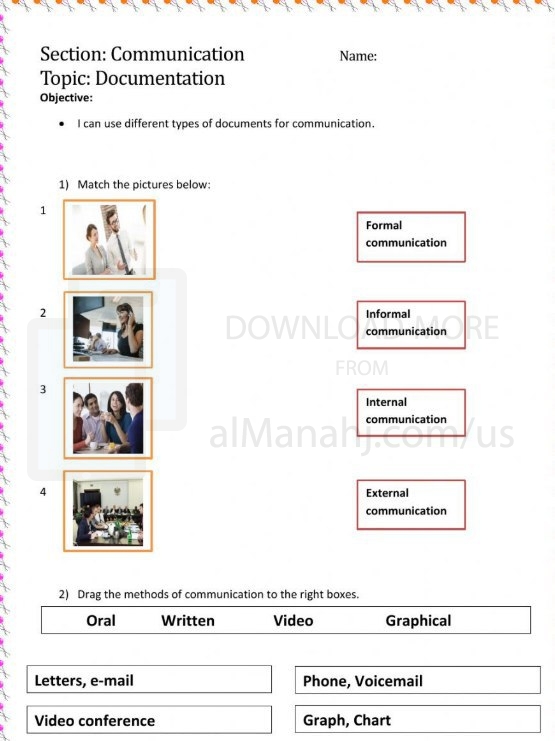| You are here: Almanahj Website ⇒ American curriculum ⇒ 9th Grade ⇒ Information and comm ⇒ Term 1 | ||
|---|---|---|
Worksheet about Different forms of documents in communication | ||
|---|---|---|
| Subject: Information and comm | ||
| 9th Grade | ||
| Term 1 | ||
| Year: 2023/2024 | ||
| Size: 353.3KB | ||
| Number of clicks: 97 | ||
| Publish date:November 15, 2023 | ||
| Added by: Eman | ||
| Last download date: 2024-09-08 06:37:19 | ||
| Updated by: Eman9966 on 2023-11-15 18:01:12 | By: theodor Preeti Bishnoi Chopra | |
| File info: In the context of communication, documents play a crucial role in conveying information, formalizing agreements, and preserving records. They serve as tangible representations of ideas, decisions, and transactions, enabling effective communication and collaboration among individuals and organizations. Here's an overview of different forms of documents commonly used in communication: Memorandums (Memos): Memos are internal documents used for brief communication within an organization or team. They typically address specific issues, provide updates, or convey instructions in a concise and straightforward manner. Reports: Reports present in-depth information on a particular subject or project, often including findings, analysis, and recommendations. They are used to share insights, document progress, or inform decision-making processes. Proposals: Proposals outline a plan or solution to a problem or opportunity, typically presented to seek approval or funding. They include a detailed description of the proposed approach, its benefits, and its implementation plan. Letters: Letters are formal written messages used for various purposes, such as correspondence between businesses, individuals, or government agencies. They can convey greetings, inquiries, requests, or complaints in a structured and professional manner. Emails: Emails have become the primary form of electronic communication, replacing traditional letters for many purposes. They allow for quick and efficient exchange of information, documents, and attachments. Legal Documents: Legal documents, such as contracts, agreements, and court filings, have specific legal implications and follow established formats. They serve to formalize legal relationships, establish rights and obligations, and provide evidence in legal proceedings. Technical Documents: Technical documents provide detailed information on technical topics, such as product specifications, user manuals, and troubleshooting guides. They are written in a clear and concise manner, using appropriate technical terminology. Creative Documents: Creative documents encompass a wide range of written works, including novels, poems, scripts, and musical compositions. They serve to express ideas, emotions, and imagination in an artistic and engaging manner. Educational Documents: Educational documents, such as textbooks, lesson plans, and research papers, are used to impart knowledge, guide learning, and present findings in a structured and informative way. Marketing Documents: Marketing documents, such as brochures, advertisements, and press releases, aim to promote products, services, or events to a target audience. They use persuasive language, visuals, and calls to action to influence consumer behavior. These diverse forms of documents play essential roles in communication, enabling the transmission of information, the formalization of agreements, and the preservation of records across various contexts. Whether in professional, personal, or creative settings, documents serve as valuable tools for effective communication and collaboration. | ||
| Downloading link Worksheet about Different forms of documents in communication |
|---|
|
1700027848.pdf
The file is being prepared for download
|
| File images |
|---|
 |